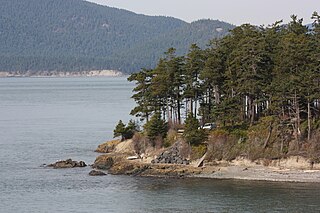
The Douglas fir is an evergreen conifer species in the pine family, Pinaceae. It is native to western North America and is also known as Douglas-fir, Douglas spruce, Oregon pine, and Columbian pine. There are three varieties: coast Douglas-fir, Rocky Mountain Douglas-fir and Mexican Douglas-fir.

Botrytis cinerea is a necrotrophic fungus that affects many plant species, although its most notable hosts may be wine grapes. In viticulture, it is commonly known as "botrytis bunch rot"; in horticulture, it is usually called "grey mould" or "gray mold".

Thuja plicata is a large evergreen coniferous tree in the family Cupressaceae, native to the Pacific Northwest of North America. Its common name is western redcedar in the U.S. or western red cedar in the UK, and it is also called pacific red cedar, giant arborvitae, western arborvitae, just cedar, giant cedar, or shinglewood. It is not a true cedar of the genus Cedrus. T. plicata is the largest species in the genus Thuja, growing up to 70 metres (230 ft) tall and 7 m (23 ft) in diameter. It mostly grows in areas that experience a mild climate with plentiful rainfall, although it is sometimes present in drier areas on sites where water is available year-round, such as wet valley bottoms and mountain streamsides. The species is shade-tolerant and able to establish in forest understories and is thus considered a climax species. It is a very long-lived tree, with some specimens reaching ages of well over 1,000 years.

Abies concolor, the white fir, concolor fir, or Colorado fir, is a coniferous tree in the pine family Pinaceae. This tree is native to the mountains of western North America, including the Sierra Nevada and southern Rocky Mountains, and into the isolated mountain ranges of southern Arizona, New Mexico, and Northern Mexico. It naturally occurs at elevations between 900 and 3,400 metres.

A bark beetle is the common name for the subfamily of beetles Scolytinae. Previously, this was considered a distinct family (Scolytidae), but is now understood to be a specialized clade of the "true weevil" family (Curculionidae). Although the term "bark beetle" refers to the fact that many species feed in the inner bark (phloem) layer of trees, the subfamily also has many species with other lifestyles, including some that bore into wood, feed in fruit and seeds, or tunnel into herbaceous plants. Well-known species are members of the type genus Scolytus, namely the European elm bark beetle S. multistriatus and the large elm bark beetle S. scolytus, which like the American elm bark beetle Hylurgopinus rufipes, transmit Dutch elm disease fungi (Ophiostoma). The mountain pine beetle Dendroctonus ponderosae, southern pine beetle Dendroctonus frontalis, and their near relatives are major pests of conifer forests in North America. A similarly aggressive species in Europe is the spruce ips Ips typographus. A tiny bark beetle, the coffee berry borer, Hypothenemus hampei is a major pest on coffee plantations around the world.

A leaf spot is a limited, discoloured, diseased area of a leaf that is caused by fungal, bacterial or viral plant diseases, or by injuries from nematodes, insects, environmental factors, toxicity or herbicides. These discoloured spots or lesions often have a centre of necrosis. Symptoms can overlap across causal agents, however differing signs and symptoms of certain pathogens can lead to the diagnosis of the type of leaf spot disease. Prolonged wet and humid conditions promote leaf spot disease and most pathogens are spread by wind, splashing rain or irrigation that carry the disease to other leaves.

Phytophthora × cambivora is a plant pathogen that causes ink disease in European chestnut trees. Ink disease, also caused by Phytophthora cinnamomi, is thought to have been present in Europe since the 18th century, and causes chestnut trees to wilt and die; major epidemics occurred during the 19th and 20th centuries. P. cinnamomi and P. × cambivora are now present throughout Europe since the 1990s. Ink disease has resurged, often causing high mortality of trees, particularly in Portugal, Italy, and France. It has also been isolated from a number of different species since the 1990s, including:
Durandiella pseudotsugae is a plant pathogen which causes Dime canker in Douglas-fir trees.
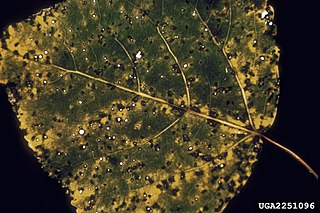
Melampsora medusae is a fungal pathogen, causing a disease of woody plants. The infected trees' leaves turn yellowish-orange. The disease affects mostly conifers, e.g. the Douglas-fir, western larch, tamarack, ponderosa, and lodgepole pine trees, but also some broadleaves, e.g. trembling aspen and poplars. Coniferous hosts are affected in late spring through early August, and trembling aspens and poplars from early summer to late fall. It is one of only two foliage rusts that occur naturally in British Columbia.

Stereum sanguinolentum is a species of fungus in the Stereaceae family. A plant pathogen, it causes red heart rot, a red discoloration on conifers, particularly spruces or Douglas-firs. Fruit bodies are produced on dead wood, or sometimes on dead branches of living trees. They are a thin leathery crust of the wood surface. Fresh fruit bodies will bleed a red-colored juice if injured, reflected in the common names bleeding Stereum or the bleeding conifer parchment. It can be the host of the parasitic jelly fungus Tremella encephala.

Rhabdocline pseudotsugae is a fungal plant pathogen. The pathogen, along with Rhabdocline weirii causes Rhabdocline needlecast; R. weirii only affects Douglas-fir trees. The disease causes the needles of the tree to discolor and eventually fall from the tree. It was originally common to the Rocky Mountain states of the United States but has since spread to Europe. Infections usually start in the spring or early summer and can change the color of the foliage to a variety of hues. The fungus produces apothecia that are normally found on the underside of needles but they also occur on the topside as well.
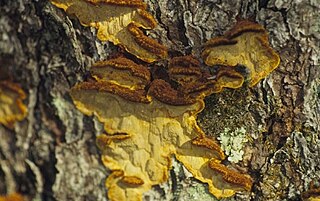
Porodaedalea pini, commonly known as the pine conk, is a species of fungus in the family Hymenochaetaceae. It is a plant pathogen that causes tree disease commonly known as "red ring rot" or "white speck". This disease, extremely common in the conifers of North America, decays tree trunks, rendering them useless for lumber. It is a rot of the heartwood. Signs of the fungus include shelf-shaped conks protruding from the trunks of trees. Spores produced on these conks are blown by the wind and infect other trees. Formal management of this disease is limited, and the disease is controlled primarily by cultural practices. Red ring rot is an important forest disturbance agent and plays a key role in habitat formation for several forest animals.

Coniferiporia weirii is a species of fungus. It is a plant pathogen that causes laminated root rot in certain conifers, typically Douglas-fir and western redcedar. It is widespread in the Douglas-fir growing regions of British Columbia, Washington and Oregon.
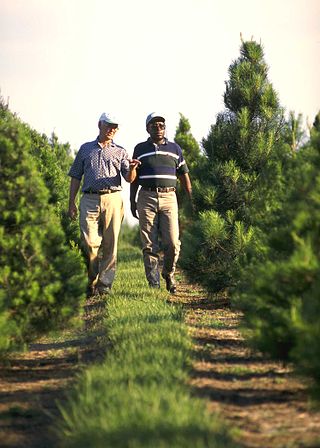
Christmas tree cultivation is an agricultural, forestry, and horticultural occupation which involves growing pine, spruce, and fir trees specifically for use as Christmas trees.
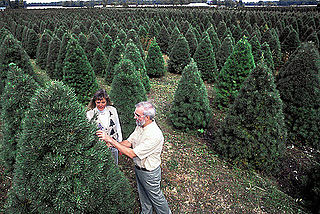
Pine and fir trees, grown purposely for use as Christmas trees, are vulnerable to a wide variety of pests, weeds and diseases. Many of the conifer species cultivated face infestations and death from such pests as the balsam woolly adelgid and other adelgids. Aphids are another common insect pest. Christmas trees are also vulnerable to fungal pathogens and their resultant illnesses such as root rot, and, in the U.S. state of California, sudden oak death. Douglas-fir trees in particular are vulnerable to infections from plant pathogens such as R. pseudotsugae.

Laminated root rot also known as yellow ring rot is caused by the fungal pathogen Phellinus weirii. Laminated root rot is one of the most damaging root disease amongst conifers in northwestern America and true firs, Douglas fir, Mountain hemlock, and Western hemlock are highly susceptible to infection with P. weirii. A few species of plants such as Western white pine and Lodgepole pine are tolerant to the pathogen while Ponderosa pine is resistant to it. Only hardwoods are known to be immune to the pathogen.

Fusarium circinatum is a fungal plant pathogen that causes the serious disease pitch canker on pine trees and Douglas firs. The most common hosts of the pathogen include slash pine, loblolly pine, Monterey pine, Mexican weeping pine, and Douglas fir. Like other Fusarium species in the phylum Ascomycota, it is the asexual reproductive state of the fungus and has a teleomorph, Gibberella circinata.

Mycorrhizal associations have profoundly impacted the evolution of plant life on Earth ever since the initial adaptation of plant life to land. In evolutionary biology, mycorrhizal symbiosis has prompted inquiries into the possibility that symbiosis, not competition, is the main driver of evolution.
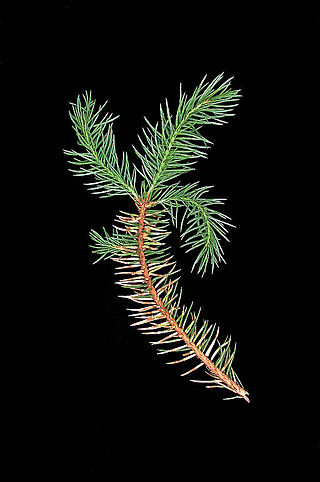
Chrysomyxa weirii, is a fungus that causes a disease, commonly known as Weir's cushion rust, of spruce trees. It is mostly a cosmetic problem, causing yellowish spotting and banding on spruce needles, but in some cases can cause severe premature defoliation. Weir’s cushion rust can also disfigure and reduce growth of spruce trees by targeting the tender needles of newly emerging shoots. This pathogen's spores are spread by wind and water splash and germinate to infect newly developing needles on the same spruce, or neighboring spruce trees. Unlike many other rust disease pathogens, C. weirii is autoecious, only infecting spruce trees. C. weirii is also microcyclic, producing only two of the five possible spore stages common in rust fungi. Trees affected by Weir's cushion rust usually have obvious symptoms, but if treated correctly, the disease can be managed.
Rhabdocline laricis, also known as Meria laricis, is a hyphomycete fungus in the family Cenangiaceae. In larch conifer trees (Larix), it causes the plant disease larch needle cast, also known as meria needle blight. It is generally harmless in older trees. However, it causes browning of needles, which can slow growth, weaken overall resistance to opportunistic pathogens, and can sometimes outright kill seedlings, making Rhabdocline laricis a threat in tree nurseries.
















